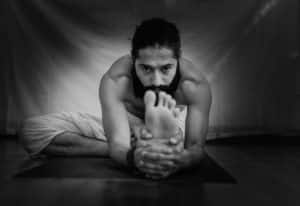
It is best to avoid practising Janu Sirsasana if you have diarrhoea or asthma.
Janu Sirsasana (Head-to-Knee Pose) is a beneficial yoga pose that provides a stretch to alleviate tightness in the hamstrings and calves. It also has a calming effect on the mind and can help relieve stress. This pose is particularly recommended for individuals experiencing menstrual cramps or menopause symptoms as it offers relief. Janu Sirsasana primarily stretches the hamstrings, hips, and groin muscles, making it an excellent choice for runners and athletes with tight hamstrings. Additionally, this forward bending pose stretches and strengthens the spinal muscles and the muscles along the sides of the back. Janu Sirsasana, or Head-to-Knee Pose, is a forward-bending yoga pose with numerous benefits. It stretches and strengthens the spine and abdominal muscles, making it helpful in managing conditions such as diabetes, cancer, irritable bowel syndrome, and gastritis.
Yoga and Spiritual Leader Himalayan Siddhaa Akshar, Founder of Akshar Yoga Institutions, shares some of the benefits of practising Janu Sirsasana:
- Muscle and joint stretching: Janu Sirsasana stretches various body parts, including the spine, liver, spleen, hamstrings, groins, and shoulders. It also stimulates the kidneys and liver, reduces waist and leg pain, and strengthens the rib bones.
- Relief from IBS symptoms: Janu Sirsasana has been found effective in reducing the intensity of symptoms associated with irritable bowel syndromes (IBS), such as pain, fatigue, and distress while improving sleep quality.
- Flexibility and therapeutic benefits: Janu Sirsasana helps make the spine flexible and is therapeutic for insomnia and high blood pressure conditions. It can also be beneficial for sinusitis.
- Obesity management: Practicing Janu Sirsasana can help stretch the abdominal muscles, potentially aiding in weight management and regulating blood sugar levels and body mass index.
- Calming and depression relief: This pose has a calming effect on the brain and can help alleviate mild depression.
- Digestive improvement: The pose can improve digestion and relieve symptoms of menopause.

READ RELATED: Monsoon Safety Tips For Senior Citizens: Avoid Wearing Leather Shoes
To Practice Janu Sirsasana, Follow These Step-By-Step Instructions:
- Begin in Staff Pose (Dandasana) with both legs extended before you.
- Avoid rounding your lower back.
- Keep your right foot flexed and press the back of your right thigh toward the floor.
- Maintain a straight spine and long neck, or relax your head and heart toward your extended leg, allowing the spine to round.
- Try to reach your foot, ankle, or calf with your hands.
- With each inhale, lengthen your spine and deepen the forward bend with each exhale.
- Stay in this position for five to 10 breaths, straighten both legs, shake them out, and repeat the pose on the other side.
It Is Essential To Note Some Contraindications For Janu Sirsasana:
- Back or knee injuries: Avoid this pose if you have any back or knee injuries. While you should feel a stretch in your muscles, stopping if you experience any pain is crucial.
- Diarrhoea or asthma: It is best to avoid practising Janu Sirsasana if you have diarrhoea or asthma.
- Lower back injuries: Individuals with severe lower back injuries or lumbar disc herniation should refrain from practising this asana.
- Listen to your body and modify the pose to suit your comfort and physical limitations. Consulting a qualified yoga instructor before attempting this pose is always recommended.
Total Wellness is now just a click away.
Follow us on
Don’t Miss Out on the Latest Updates.
Subscribe to Our Newsletter Today!
window.addEventListener(‘load’, (event) => {
$(‘#commentbtn’).on(“click”,function(){
(function(d, s, id) { var js, fjs = d.getElementsByTagName(s)[0]; if (d.getElementById(id)) return; js = d.createElement(s); js.id = id; js.src = “//connect.facebook.net/en_US/sdk.js#xfbml=1&version=v2.3”; fjs.parentNode.insertBefore(js, fjs);}(document, ‘script’, ‘facebook-jssdk’));
$(“.cmntbox”).toggle();
});
});








